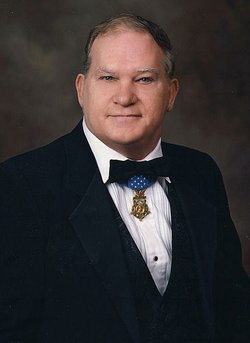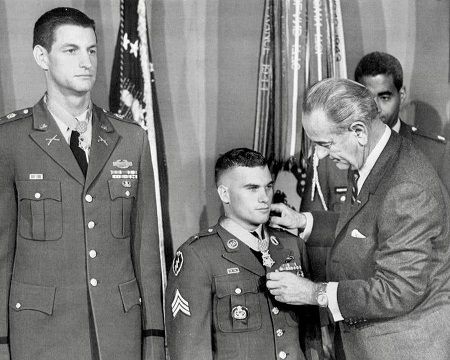Vietnam War Medal of Honor Recipient. Born in Davenport, Iowa, he majored in gymnastics at Moline High School and joined the US Army in 1966. He served as a Private in A Company, 2nd Battalion of the 27th Infantry, 25th Division. In Vietnam during Operation Attleboro (September to November 1966), the 5'2" Baker specialized as a "tunnel rat," clearing out hidden enemy positions while armed only with a pistol and a flashlight. He was promoted to Sergeant and awarded the Medal of Honor for his actions on November 5, 1966. His citation reads: "For conspicuous gallantry and intrepidity in action at the risk of his life above and beyond the call of duty. En route to assist another unit that was engaged with the enemy, Company A came under intense enemy fire and the lead man was killed instantly. Sgt. Baker immediately moved to the head of the column and together with another soldier knocked out 2 enemy bunkers. When his comrade was mortally wounded, Sgt. Baker, spotting 4 Viet Cong snipers, killed all of them, evacuated the fallen soldier and returned to lead repeated assaults against the enemy positions, killing several more Viet Cong. Moving to attack 2 additional enemy bunkers, he and another soldier drew intense enemy fire and Sgt. Baker was blown from his feet by an enemy grenade. He quickly recovered and single-handedly destroyed 1 bunker before the other soldier was wounded. Seizing his fallen comrade's machine gun, Sgt. Baker charged through the deadly fusillade to silence the other bunker. He evacuated his comrade, replenished his ammunition and returned to the forefront to brave the enemy fire and continue the fight. When the forward element was ordered to withdraw, he carried 1 wounded man to the rear. As he returned to evacuate another soldier, he was taken under fire by snipers, but raced beyond the friendly troops to attack and kill the snipers. After evacuating the wounded man, he returned to cover the deployment of the unit. His ammunition now exhausted, he dragged 2 more of his fallen comrades to the rear. Sgt. Baker's selfless heroism, indomitable fighting spirit, and extraordinary gallantry were directly responsible for saving the lives of several of his comrades, and inflicting serious damage on the enemy. His acts were in keeping with the highest traditions of the U.S. Army and reflect great credit upon himself and the Armed Forces of his country." Baker's commander, Robert Foley, also received the Medal of Honor for the unit's action. Baker became a career soldier, attaining the rank of Master Sergeant before his retirement in 1989, and maintained ties with the military in his civilian life. He worked as a computer analyst at a South Carolina Veterans Hospital, was Vice President of the Medal of Honor Society, and was a member of the Nation's Monuments and Cemeteries Committee. A bridge connecting his native Davenport with Rock Island, Illinois, was renamed for him in 2008. Baker died at his home in Columbia, South Carolina, after a long battle with heart disease.
Vietnam War Medal of Honor Recipient. Born in Davenport, Iowa, he majored in gymnastics at Moline High School and joined the US Army in 1966. He served as a Private in A Company, 2nd Battalion of the 27th Infantry, 25th Division. In Vietnam during Operation Attleboro (September to November 1966), the 5'2" Baker specialized as a "tunnel rat," clearing out hidden enemy positions while armed only with a pistol and a flashlight. He was promoted to Sergeant and awarded the Medal of Honor for his actions on November 5, 1966. His citation reads: "For conspicuous gallantry and intrepidity in action at the risk of his life above and beyond the call of duty. En route to assist another unit that was engaged with the enemy, Company A came under intense enemy fire and the lead man was killed instantly. Sgt. Baker immediately moved to the head of the column and together with another soldier knocked out 2 enemy bunkers. When his comrade was mortally wounded, Sgt. Baker, spotting 4 Viet Cong snipers, killed all of them, evacuated the fallen soldier and returned to lead repeated assaults against the enemy positions, killing several more Viet Cong. Moving to attack 2 additional enemy bunkers, he and another soldier drew intense enemy fire and Sgt. Baker was blown from his feet by an enemy grenade. He quickly recovered and single-handedly destroyed 1 bunker before the other soldier was wounded. Seizing his fallen comrade's machine gun, Sgt. Baker charged through the deadly fusillade to silence the other bunker. He evacuated his comrade, replenished his ammunition and returned to the forefront to brave the enemy fire and continue the fight. When the forward element was ordered to withdraw, he carried 1 wounded man to the rear. As he returned to evacuate another soldier, he was taken under fire by snipers, but raced beyond the friendly troops to attack and kill the snipers. After evacuating the wounded man, he returned to cover the deployment of the unit. His ammunition now exhausted, he dragged 2 more of his fallen comrades to the rear. Sgt. Baker's selfless heroism, indomitable fighting spirit, and extraordinary gallantry were directly responsible for saving the lives of several of his comrades, and inflicting serious damage on the enemy. His acts were in keeping with the highest traditions of the U.S. Army and reflect great credit upon himself and the Armed Forces of his country." Baker's commander, Robert Foley, also received the Medal of Honor for the unit's action. Baker became a career soldier, attaining the rank of Master Sergeant before his retirement in 1989, and maintained ties with the military in his civilian life. He worked as a computer analyst at a South Carolina Veterans Hospital, was Vice President of the Medal of Honor Society, and was a member of the Nation's Monuments and Cemeteries Committee. A bridge connecting his native Davenport with Rock Island, Illinois, was renamed for him in 2008. Baker died at his home in Columbia, South Carolina, after a long battle with heart disease.
Bio by: Bobb Edwards
Family Members
Advertisement








